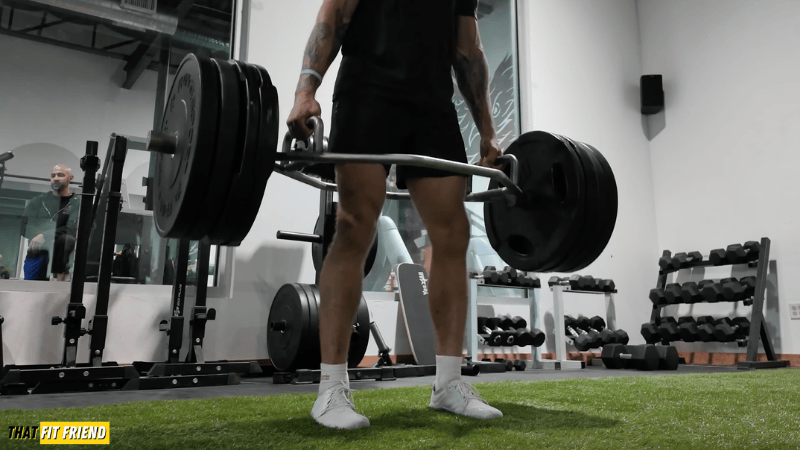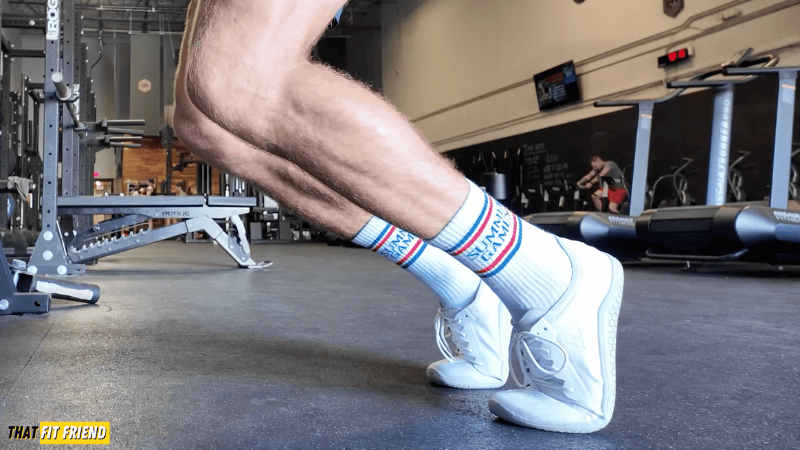That Fit Friend is supported by its readers. I [Jake Boly] run this site myself and buy the gear I review. If you purchase through my site, I may earn commissions on sales, read more here!
Table of Contents+
If you’re sitting here saying, “What’s actually different with the Primus Lite 3.5? It looks exactly like the 3,” you’re not alone. Whenever I see shoes with a .5 in their name, I assume there have been quality-of-life updates made, but not necessarily full overhauls, which seems to be the case here, too.
That said, and to play devil’s advocate with myself, we do have the Primus Lite IV AW, and they’re not that much different regarding their core DNA, so maybe I’m totally off with my .5 sentiment above.
With the 3.5, my main questions revolved around “why?” and “did they mess it up?” As in, did Vivobarefoot try to rethink the wheel on a seemingly solid 3? After multiple training sessions and putting them through a 2-hour long scuff test, I have a fairly good grasp of the need-to-knows with the 3.5.

Who Should Buy the Primus Lite 3.5?
- Do-It-All Shoe Buyers. The Primus Lite 3.5 is awesome if you want a shoe for casual wear and training. They look good and work great for lifting, cross-training, and athletic-style workouts.
- You Live In a Warm Climate. The mesh upper on the 3.5 is super breathable and this model is a good option for those who love wearing socks and going sockless (*gasp*). Don’t @ me about it being gross, as long as you’re strategic, they don’t stink!
- You’re a Quality Lover. Here’s the thing: these are more expensive than other options you’ll find on places like Amazon, but you pay for what you get. Say what you want about Vivobarefoot’s prices. However, they do honor products with issues, which I’ll discuss below. You’re not getting white labeled products with these.

Who Shouldn’t Buy the Primus Lite 3.5?
- Powerlifters Needing Something to Compete In. I love the Primus Outsole, but it’s not the grippiest outsole in the game. If you’re a diehard strength sports athletes, read: powerlifter, you’ll want to go with something more optimized for your sport such as the AVANCUS Apex Power or Notorious Lift Radix.
- Barefoot Shoe Beginners. Don’t get me wrong, these can work great for beginners, but if you’re brand new to barefoot shoes, you may want something with a thicker stack height for acclimation purposes. Models like the Lems Primal Zen and WHITIN Barefoot Shoe can work great here.
- Budget Shoppers. If you don’t have the money for a $160 barefoot shoe, I can’t fault you there. For maximal savings, look into models like the AIRHAS Barefoot Shoes. They have good versatility and are super cheap. Keep in mind, you are kind of paying for white labeled shoes with them. They don’t really have the brand/vibe that I typically try to support, I can’t judge you for wanting to save in this economy, though.
- You Do Explosive Training and Need a Snugger Boot. The softer boot in this model is great for comfort but can feel a little loose when tackling a lot of explosive work.

What’s New? Primus Lite 3 vs 3.5
The Pimus Lite 3 and 3.5 look nearly identical and a lot of the core elements of the shoe remain the same. I think that’s the reason Vivobarefoot went with the .5 in the name. There are some updates, but it hasn’t been a full reworked iteration.
Reworked Upper: Neutral change. The mesh feels softer around the forefoot and heel in the 3.5 and it has more recycled polyester than the 3. The reason I have this as neutral is because I’ve had some in my community mention rip issues around the toe box. Vivobarefoot replaced their shoes, but it’s still a neutral change in my eyes until we have more long-term aggregated community feedback before I label it as outright positive.


The above is pretty much all you need to know regarding “what’s actually different.” The silhouette, shape, insole, and outsole all remain the same and they fit very similar to the Primus Lite 3.
My Sizing and Fit Suggestions
As mentioned above, the Primus Lite 3.5 will size the EXACT same as the Primus Lite 3. If you’ve never worn the 3, then I have some suggestions for you. Vivobarefoot models can sizes…let’s just say interestingly for some.
I wear a 10 in all of the shoes I review and have an E/EE-width foot, so when I draw conclusions on various models, please note, that’s the context I’m drawing from. If you have additional questions about the 3.5’s sizing, drop a comment below and I’ll get back to you.
Narrow Foot Sizing Suggestions
- True to size for some, size down for some.
If you have a narrow foot and you like extra room at the end of your toe box, go true to size. For those who have a thumb’s width of space at the end of their CURRENT shoes and like a snugger fit with less space in the boot, consider sizing down.

If you’re in-between sizes and have narrow feet, I’d size down. These can run long, and I don’t want you to have boot security issues.
Medium-Width Foot Sizing Suggestions
- Go true to size.
For most medium-width feet, true to size will be the call. If you prefer a snugger fit and have a lot of room in your current shoe’s toe box, though, then you may want to consider sizing down. However, these will be rare one-off cases.
If you’re between sizes, I’d suggest sizing down for a snugger fit. Go up if you like a lot of room in your toe box.

Wide Foot Sizing Suggestions
- Go true to size.
For wider feet, true to size is the move. Vivobarefoot aren’t the widest barefoot shoes in the game, so having a more spacious fit isn’t a bad thing for 2E+ foot widths. If you’re between sizes, I’d go up if you have a 2E+ foot width and down if you’re an E-width.
For flatter feet, these tend to fit pretty well and true to size due to their flatter sole and lack of midfoot to forefoot taper.
Using the Primus Lite 3.5 for Lifting
The Primus Lite 3.5s have been exceptional for lifting. To be fair, my first love in the world of barefoot shoes was the Primus Lite 3. In fact, my first pair of those is still going strong and has since started to turn a little yellow due to my sweat. Something I’ve noticed with the 3.5 is the upper seems to maintain its color better than the 3, which has been a subtle pro I’ve noticed in my lifting sessions.

The 3.5 has worked best for my strength and hypertrophy sessions, where I’m tackling things like deadlifts, RDLs, leg press, and split squats. The Primus Outsole is awesome for getting you close to the ground, and these are plenty wide for promoting toe splay.
For lower sessions, the flexibility of the sole has been a nice perk. When doing lunges and sissy squats, this shoe articulates well. Plus, if you take the insole out, you can get even closer to the ground for my diehard barefoot shoe lovers.


My only gripe with this shoe for lifting is that it’s not my favorite model for things like power cleans and more dynamic heavy lifts. With the lighter weight boot, you don’t get as much security as other models like the Tolos Archetype 2.0 and Motus Strength.
Cross-Training, Short Runs, and Walking Assessment
For cross-training, the 3.5 has been a solid shoe overall. It has good breathability, flexibility, and enough security for the types of workouts I’ve tested them in. In the lens of cross-training, this means a lot of kettlebell flows, plyometrics, and multi-directional exercises — think athletic-style workouts.
The Primus Outsole is great for giving you a ton of ground feel and it’s nice having the insole to keep in when you’re jumping a lot. It helps give you a little extra comfort in these shoes. The outsole also has a good enough grip on most surfaces. If I was hitting kettlebell snatches and swings on turf, I never had slip issues, and they do the best on rubber gym floors.

The only caveats I have with the Primus Outsole, and this has been the case in all of the Primus iterations, is that it can slip a bit when doing heavy sled work on turf. Not to mention, the boot in the 3.5 is a little loose with its material change so the lockdown could be better. For sled workouts on turf, I’d rather train in the Motus Strength or Inov8 Bare XF. Their outsoles do a much better job with bite in this context.
From a lateral security context, these have done an okay job. They have enough material to lock you down, but it’s worth noting that they are a lighter-weight shoe. If you have exceptionally wide feet and you’re prone to spilling over in your shoes, then you may want to find a wider model with more upper reinforcement like the Be Lenka Velocity.
Cross-training bottom line: The 3.5 should be fine for most needs when it comes to cross-training sans the specific cases mentioned. If you need maximal grip and upper security, there are better options out there.



When it comes to running, I’ve specifically tested this shoe for 400-800 meter intervals and 1.5 mile recovery runs. I have NOT used this shoe for long runs, so if you’re after that information, I won’t be your guy. You may want to check out my man Barefoot Run Review for that information, as he’s a running-focused athlete, whereas I’m more of a hybrid guy.
For my short intervals and slow runs, I’ve liked the Primus Lite 3.5. They’re not technically “built” for running, but they’ll suffice if your runs are chiller. The flexibility and breathability were my favorite aspects of this shoe, and the midfoot security is good enough for faster paces. I’ve also been impressed with the Primus Outsole and how long it lasts — I even did a scuff test in them, and they earned my respect.
The casual wear crossover with the 3.5 is a big win, and I think they’ve done a good job with colorways thus far. I’ve been able to dress these shoes up relatively easily, and I think they can be a good option for casual office wear and rocking all day.
Construction Details
Outsole


- Primus outsole
- 2mm tread depth, 2mm sole base
- Flexible construction
- Hexagon tread pattern
Upper

- Mesh upper with textile overlays
- Ventilated forefoot
- Upper is built with 81% polyester, of which 94% is recycled
- Textile overlays cover heel, midfoot, and toe for durability
Insole

- Ortholite insole
- Insoel is built with 98% recycled PU foam
- Removable with a finished internal construction
Final Verdict: Are They Worth Your Money?
It depends.
The Primus Lite 3.5 has been a good shoe, and I’ve been happy with them overall. If you want that “do-it-all” barefoot shoe for casual wear and gym use, then you’ll resonate with this model.
These also tend to be good for medium to slightly wider foot widths. My hangups with them revolve around two things.
One, if you’re a budget shopper, you can find equally strong barefoot shoes for less. You’re not missing anything by not buying these. Two, the forefoot upper has had issues for a few members in my community. Luckily, Vivobarefoot replaced their shoes — which I like — but I don’t love that some are running into issues after a few months of wear (it’s a variable durability issue).
If you have additional questions about this shoe, drop a comment below or reach out on Instagram.







Add a Comment